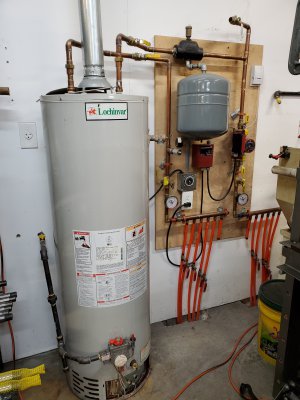-
Welcome back Guest! Did you know you can mentor other members here at H-M? If not, please check out our Relaunch of Hobby Machinist Mentoring Program!
You are using an out of date browser. It may not display this or other websites correctly.
You should upgrade or use an alternative browser.
You should upgrade or use an alternative browser.
Tankless Water Heater Troubles
- Thread starter ddickey
- Start date
- Joined
- Jan 7, 2016
- Messages
- 3,279
Errmm. Well, heck, I don't know. LOL.No not 62%. You forgot to add the entire volume. Let's say 14 gallons total and I used 5 glycol. Wouldn't that be 5/14 = 35%?
If you used 4 gallons to the 8 gallons that would be 50%. Right? 50-50 mix.
So 5 gallons to 8 gallons (which is 13 gallons btw) is 5/8=.62 or 62%
Not snowing yet.
Last edited:
lol you got me thinking now.
And yes to 5 gallons to eight is 62% but that is assuming you have a total capacity of 8 gallons.
Lets say total volume in the system is 14 gallons. I'd have to add 7 gallons of glycol and 7 of water to get a 50% mix.
Think of it this way. If I used 4 gallons of glycol according to what you're saying I'd have a 50% mix but then I'd have to add 4 gallons of water 50/50 but I'm still short 5 gallons in the system (assuming 13 gallons).
And yes to 5 gallons to eight is 62% but that is assuming you have a total capacity of 8 gallons.
Lets say total volume in the system is 14 gallons. I'd have to add 7 gallons of glycol and 7 of water to get a 50% mix.
Think of it this way. If I used 4 gallons of glycol according to what you're saying I'd have a 50% mix but then I'd have to add 4 gallons of water 50/50 but I'm still short 5 gallons in the system (assuming 13 gallons).
Also the heater is squealing and squawking ex
The sound from the video reminds me of boiler hammer that I heard at the plant where I worked many moons ago. The noise is caused by steam rapidly condensing to water and creating a vacuum. That is similar to propeller cavitation where small air bubbles rapidly collapse and create vibration from rapid pressure changes.the real cause of it getting louder is when you increase the output temperature.
From what you have written I think that you might just need to raise the temperature of the system more gradually. If the heating element is too hot with respect to the heat transfer rate then there could be small bubbles of steam that develop on the surface of the heater that collapse rapidly. Adjusting flow rates and glycol mix to optimum values will certainly help but I suspect that giving the system more time to stabilize will do the most good. Avoid the noise at all costs, that type of vibration can be very damaging to the system.
You might be right but I can't do that. The problem is the air temp increases and the temp controller shuts off the pump then the heater shuts down so there is never really a nice heat up on the return supply. The return temp is ~62° give or take depending on how long it has been running. I could lower the output temp maybe that would cause it to run longer and increase the temp of the return, idk worth a try. But still if you think about it water coming from a well has got to be less than 62°. So the normal configuration of this heater would be to heat water for use in the shower or sink or whatever.
- Joined
- Feb 5, 2018
- Messages
- 638
Here is a picture of my system in my shop. I have been using it for about 5 years now. I had a lot of issues trying to get all the air out of it. It would circulate ok and when it shut off, it would cavitate and not flow. Each time I thought it was bled out I would crack a valve and more air would blow out.
Joe

Joe

Here's a link to my exhaust/intake which drips with condensation. Disclaimer: I did not do put up the plywood.
0 new items by Duane Dickey
photos.app.goo.gl
Condensation is highly acidic. Your water heater is a goner.
If that's exhaust condensation I mean.
Here is a picture of my system in my shop. I have been using it for about 5 years now. I had a lot of issues trying to get all the air out of it. It would circulate ok and when it shut off, it would cavitate and not flow. Each time I thought it was bled out I would crack a valve and more air would blow out.
Joe
View attachment 348888
Expansion tank should not be hanging like that. The weight of the water kinda kills the expansion capabilities.
Depends on what is high. I know it is slightly acidic about the same as a tomato from what I understand.
My heater is a goner? Well that was quick. Less than a month.
My expansion tank sits the same as Liljoebrshooter but mine is small @ 2.2 gallons.
My heater is a goner? Well that was quick. Less than a month.
My expansion tank sits the same as Liljoebrshooter but mine is small @ 2.2 gallons.
Last edited:

